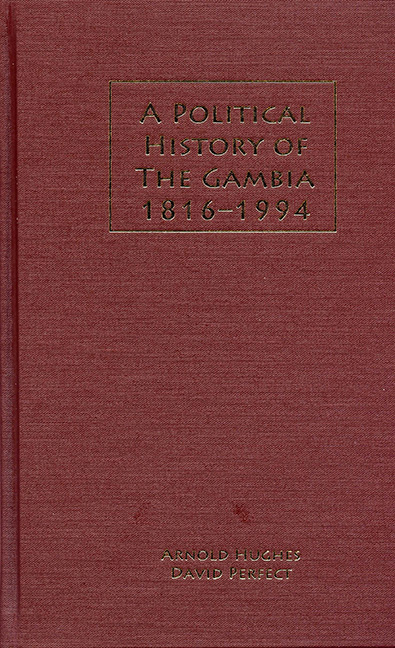Book contents
- Frontmatter
- Dedication
- Map
- Contents
- List of Tables
- List of Interviewees
- Acknowledgments
- Abbreviations
- Introduction
- 1 Social and Economic Setting
- 2 Constitutional Change in The Gambia, 1816–1994
- 3 Merchants and Recaptives: The Origins of Modern Politics, 1816–86
- 4 Patrician Politics in the Era of the Forsters, 1886–1941
- 5 The Establishment of Party Politics, 1941–59
- 6 The “Green Uprising”: The Emergence of the People's Progressive Party, 1959–65
- 7 Electoral Politics, 1965–81
- 8 Radical and Insurrectionary Political Challenges, 1965–81
- 9 Electoral Politics, 1981–94
- 10 The Gambia's External Relations, 1965–94
- 11 The 1994 Coup and the Jawara Legacy
- Appendix A Major Constitutional Changes, 1816–1994
- Appendix B Legislative Council Election Results, 1947–54
- Appendix C General Election and By-Election Results, 1960–93
- Appendix D Presidential Election Results, 1982–92
- Appendix E Republic Referendum Results, 1970
- Appendix F Primary Sources
- Appendix G Newspapers and Magazines Consulted
- Notes
- Bibliography
- Index
- Rochester Studies in African History and the Diasora
2 - Constitutional Change in The Gambia, 1816–1994
Published online by Cambridge University Press: 13 April 2017
- Frontmatter
- Dedication
- Map
- Contents
- List of Tables
- List of Interviewees
- Acknowledgments
- Abbreviations
- Introduction
- 1 Social and Economic Setting
- 2 Constitutional Change in The Gambia, 1816–1994
- 3 Merchants and Recaptives: The Origins of Modern Politics, 1816–86
- 4 Patrician Politics in the Era of the Forsters, 1886–1941
- 5 The Establishment of Party Politics, 1941–59
- 6 The “Green Uprising”: The Emergence of the People's Progressive Party, 1959–65
- 7 Electoral Politics, 1965–81
- 8 Radical and Insurrectionary Political Challenges, 1965–81
- 9 Electoral Politics, 1981–94
- 10 The Gambia's External Relations, 1965–94
- 11 The 1994 Coup and the Jawara Legacy
- Appendix A Major Constitutional Changes, 1816–1994
- Appendix B Legislative Council Election Results, 1947–54
- Appendix C General Election and By-Election Results, 1960–93
- Appendix D Presidential Election Results, 1982–92
- Appendix E Republic Referendum Results, 1970
- Appendix F Primary Sources
- Appendix G Newspapers and Magazines Consulted
- Notes
- Bibliography
- Index
- Rochester Studies in African History and the Diasora
Summary
This chapter briefly describes the constitutional evolution of The Gambia between 1816 (the date of the foundation of Bathurst) and 1994; key events are analyzed in detail in subsequent chapters. The constitutional status of The Gambia is discussed first. The Gambia was a British colony between 1821 and its achievement of independence in 1965. It became a republic in 1970, but remains within the Commonwealth. The machinery of government is then considered. After 1843, this consisted of the typical colonial instruments of an Executive and a Legislative Council. The former functioned until 1963 and the latter until 1960.
During the colonial period, the Legislative Council enacted laws that affected both the Colony and the Protectorate; however, the two parts of Gambia were administered locally in very different ways. Because developments in the Protectorate had very little impact on politics at a national level, this is not a major focus of the book, but we nevertheless briefly discuss the process by which the Protectorate was governed.
In July 1994, the civilian government was overthrown by a military coup and the House of Representatives was abolished; it was eventually replaced by a National Assembly under a new constitution in 1997. For ease of reference, the constitutional changes described here are summarized in Appendix A.
The Constitutional Status of The Gambia, 1816–1994
The origins of modern Gambia can be traced to April 1816 when an expeditionary force from Gorée under Captain Alexander Grant took possession of Banjul Island, renamed it St. Mary's, and established a settlement. Named Bathurst after the secretary of state for the colonies, Earl Bathurst, this was not the first settlement on the River Gambia. A British garrison had been established as early as 1661 at James Island, some 25 miles from the river mouth, but was abandoned (not for the first time) in 1779. The “Company of Merchants trading to Africa,” which had administered James Island between 1750 and 1766, had regained nominal control over the area in 1783, but had made no attempt to reoccupy the fort after 1788 and was not involved in the new venture. The initiative had in fact been taken by Earl Bathurst, who had been persuaded that the suppression of the slave trade and the development of “legitimate” trade, could only be achieved if a British force were to control the river.
- Type
- Chapter
- Information
- A Political History of the Gambia, 1816–1994 , pp. 41 - 54Publisher: Boydell & BrewerPrint publication year: 2006

